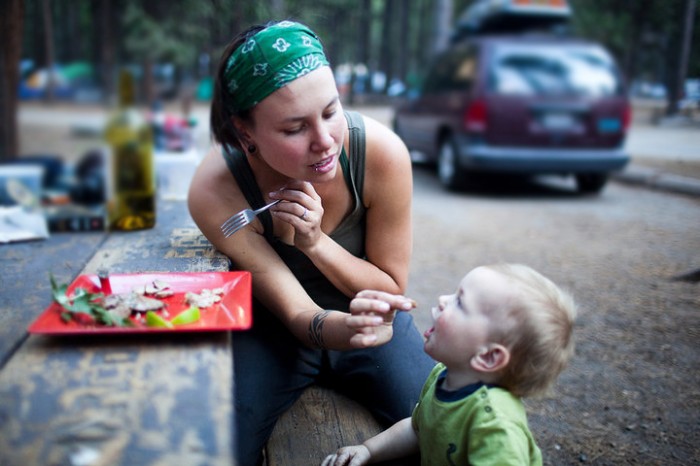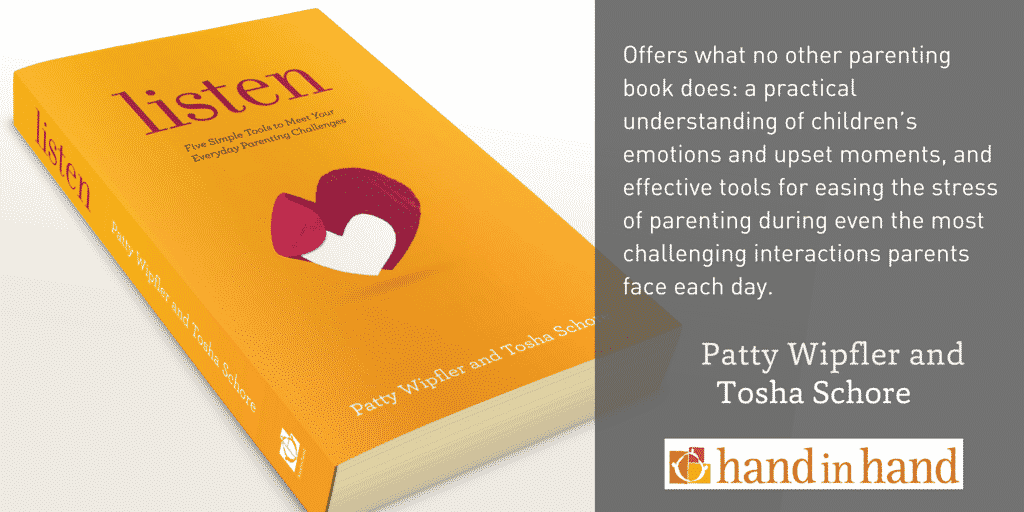Helping children learn to deal with the desire for instant gratification is a big part of parenting
A big part of our experience as parents has to do with developing ways to address the deeply felt wants and needs of our children. We deal with wants and needs from our babies' earliest moments through their entry into young adulthood. We have to figure out what our children's real needs are, and what to do when they want instant gratification or things they don't need or can't have. And we have to deal with our own feelings of sadness, frustration, or anger about how much they need and want. We talk more about this in our new book Listen. We are dedicated to making life as good as possible for them, but sooner or later we find it hard to be generous when our own needs for rest, reassurance, and resource aren't well met.
 This article won't try to point out the difference between needs and wants at a particular age or stage. Suffice it to say here that children need lots of undivided, warm attention from their parents and others around them. They need to be treated with respect. They need play, lots of room to experiment, and lots of positive response to who they are and what interesting experiments they do.
This article won't try to point out the difference between needs and wants at a particular age or stage. Suffice it to say here that children need lots of undivided, warm attention from their parents and others around them. They need to be treated with respect. They need play, lots of room to experiment, and lots of positive response to who they are and what interesting experiments they do.
They need information about what's going on around them, from the very beginning: their minds work beautifully, and from birth they fully understand the emotional import of every interaction with us. They also understand far more language than we realize. Even when we meet their needs well, there are moments every single day when our children long for attention or for things we can't give them the moment they feel the need. When Mommy and Daddy can handle these moments of intense longing gently and with understanding, it makes a huge difference in a child's life.
Feelings of need can persist after the needy moment has passed
Children acquire feelings of neediness—need for attention, need for food, need for physical closeness, need for reassurance that everything is all right—during moments when they are frightened or sad. These moments occur in every child's life, no matter how attentive the parents may be.
An example of such a moment might be a baby who is feeling pain from teething, and is hungry. He takes the breast or bottle, only to find that it hurts, so our efforts to help him with his hunger can't rectify the entire situation. He nurses and cries, nurses and cries, and we feel sad or frustrated, wishing we had a magic answer. Even after he’s done with teething, his emotional memory may retain those feelings.
Sometimes children experience a big need that isn't filled—the need to feel safe and close and cherished in the days right after birth, for example. When a baby has to be medically treated or separated from his parents for other reasons, he has feelings of need and fear that aren't addressed by the not-so-personal care of the hospital staff. When baby finally gets back to his parents’ arms, his present needs are being met at last, but the feelings of need from that scary earlier time may linger and make him jumpy, restless, unable to sleep well, or given to long crying spells for no apparent reason.
Sometimes a child acquires a collection of feelings from incidents we adults consider uneventful, such as Daddy going to work in the morning, or Mommy abruptly leaving him to answer the phone or help with the older children's homework. In any case, these big and little experiences of need leave packets of feelings that a child then carries along with him until he can heal from the hurt, large or small.
“I need my Mommy” or “I want attention” or “I'm afraid to be more than an arm's length away from my Daddy” feelings can keep a child from exploring confidently, from making friends, and from noticing that he's safe with trusted relatives or caregivers. Sometimes such feelings hinder a child only under certain circumstances—when he's tired, or when lots of people are around, or when the parents are affectionate with each other. Sometimes such feelings operate most of the time, making it seem like the child is “shy” or “timid” or “selfish.” The “feelings of need” signals can become so persistent that they govern the child's personality.
Children try to shed these leftover feelings
 Somewhere deep inside themselves, children know that these feelings need to be addressed. It is not yet commonly understood that children will instinctively set up situations in which it's impossible for you to meet their stated “needs.” They do this so that they can feel the need fully, show you how they hurt, cry or tantrum about it, and thus eliminate the hold the feeling has on them. Then they can function more logically and boldly, and feel much better about themselves.
Somewhere deep inside themselves, children know that these feelings need to be addressed. It is not yet commonly understood that children will instinctively set up situations in which it's impossible for you to meet their stated “needs.” They do this so that they can feel the need fully, show you how they hurt, cry or tantrum about it, and thus eliminate the hold the feeling has on them. Then they can function more logically and boldly, and feel much better about themselves.
This is why your toddler may throw down a toy from his high chair, whine to get it back, and when you give it back, look unhappy and throw it down again. He's trying to “work on” wanting! Children's instincts on how to set up a good cry, to unload the outdated feelings of want that don't really fit the present situation, are remarkable.
For instance, one three-year-old girl I know was being weaned from her bottle, to which she was very attached. Her Mom knew that holding her and loving her well while she cried about wanting her bottle (she would refuse the cup of milk her mother offered) was a good way to help her daughter work through this attachment without feeling abandoned or neglected.
Gradually, with several cries about desperately needing her bottle, she was spending more time playing without her bottle hanging from her mouth, and her general confidence was growing. One day, she gave her Mommy her bottle, and asked her to put it high up on a shelf across the room. Mystified, her Mom did what she asked, and returned to her daughter, who climbed into her mother's lap and began to cry heartily about wanting her bottle. She had set up her own time to cry about wanting her bottle!
Often, children will squabble over who gets a desired toy, or who gets to sit on Daddy's lap, or who got the most ice cream in their bowl. These squabbles can expose deep feelings of need, all wrapped around issues that are not, in the big picture, vital to the child. If a child is trying to work through his feelings of need, you will notice that although you try to fix things to make them “fair” or “equal,” your child can't relax and enjoy the improved situation. He becomes defensive, runs away with the toy or hoards it, or remains otherwise isolated or unhappy although the situation appears to be fixed. The feelings of need are still operating strongly, and they will continue to make your child unreasonable.
Your attention is a powerful balm
To address these feelings of need, a good long-range policy for squabbles is to move in and offer love and attention to the child whose turn it isn't, or who can't have what or who he wants. Move in and make gentle contact. Let him know that this time, he needs to wait, or that he simply can't have what he longs for right now.
Stay, listen to his feelings, and keep letting him know that he will get a turn, or that some other day, he can sit in the chair next to Daddy, or have more ice cream. “I'll help you wait” is a good reassurance to give, or “Sally will be finished with it sometime. I don't know when. But I'll help you wait.” We call this kind of listening “Staylistening.”
A child can use wanting a turn or wanting more of something as a valve to let out lots of stored, outdated longings that keep him from feeling fully pleased with you and with life. You can give warm eye contact and loving touch, knowing that you and your love are pouring into some needy places in his experience. His feelings will be strong, in fact, the sweeter you sound, the bigger his cry will become. The healing process is full-throated when it's going well!
When children are feeling needy, you are the balm that they need. Your attention is by far the most powerful remedy, and if they can cry or tantrum with your attention surrounding them, you can be sure that they are getting what they need most in the world. When you can't be there, and it's you they are longing for, any adult who can listen and love them while they cry will soon be seen as their very best friend and confidant.
Listening and love are what we need when we're aching for someone or something. It's great to get the person or thing you want, but when that's not possible, it's great to have someone who opens their arms to you, listens, and lets crying do its healing work.
With the “I'll help you wait, and listen to your feelings” policy, every child in the family (or in the play group or nursery school) will have a chance to be helped with their leftover feelings of wanting as time goes by. Every child will have the chance to dissolve outdated feelings of need that create defensiveness or aggression. Several good cries with a loving adult can help each child move toward playing flexibly and showing generosity to other children.
It's not easy to listen to children's longings
When you begin allowing your child a good cry or tantrum, you'll have lots of feelings of your own to cope with, too. We parents tend to swing back and forth between feeling sad that our child doesn't have what he wants, and mad that we have to listen to such a fuss. We can also become deeply miffed by other children who, because feelings of wanting have infected their behavior, “hog” the toy our child wants for what seems like ages!
Our feelings are important too. They lead us to emotional debris from situations we faced many times as children, usually without someone to hold us and reassure us that all would be well. We need chances to talk about our own experiences as parents, and our memories of childhood, to begin to heal the tensions that build up when our children, or other people's children, are feeling heartbroken.
Listening to longings is a much-needed skill
Our world will become a very different place when we parents have spread the word about staying close and affectionate while our children cry and tantrum about the things they can’t immediately have. Children will have the chance to grow up with permission to unload bad feelings, and then to absorb our deeply satisfying attention. The empty and frightened spots inside them will have a chance to heal.
We are citizens of a world full of people whose feelings of desperation need to be heard and healed, while justice is built. Offering love and listening to children while they wait for what they want is an important step in an excellent direction. And, fortunately, children with parents who set reasonable limits and then Staylisten to their feelings grow up to be thoughtful, responsible, and considerate adults.
Here's how it works
Here's a story that illustrates how helping a child work on wanting (and not wanting) can help her dissolve feelings about the bigger difficulties of her life.
My daughter is three, and she's going to pre-school now. My husband and I have recently separated. Ella loves school. She talks about it enthusiastically when she's at home, and she likes being there, but has a very difficult time when I leave her there. She wraps herself around me, clings tightly, and won't let me get out the door. This has been going on for awhile.Yesterday, after we got home from school, she was feisty and cranky. I was fixing her a snack, and I could tell that bad feelings were close to the surface. The last straw for her was that the chair I had set out for her was in the “wrong” place. I knew that this was an opportunity to help her with how she felt, so I didn't fix it. She ran across the room, upset about the chair. I went over to sit next to her. She was trying to cry, but wasn't crying yet—it was a kind of “fake” crying. I sat with her, and told her as gently as I could, “That chair is just in the wrong place,” trying to help her feel her upset fully. She said, “I don't need you!” and ran away from me.
I moved to about four feet away from her again, and said, “I'm going to stay nearby, I don't want to leave you right now.” She kept moving away from me, across the room or into another room, and I kept moving near her again. Each time she became more upset and getting closer to a real cry. Finally, as I moved in towards her she didn't run away. Instead she lay on the floor kicking and repeating, “I don't need you!” Then, I said, “I'm sorry I can't stay with you in the morning at school, but I just can't.” She began to cry hard. I asked, “Does it make you mad?” She nodded no. I asked, “Does it make you sad?” She nodded no, then she nodded yes, and began to cry really hard.
I told her again that I was sorry I couldn't stay with her in the mornings at school. She kept crying hard, and began to say, “I want Mommy! I want Mommy!” She was sobbing, and she came and curled into my arms and cried hard for awhile. It was lovely to hold her and help her with these feelings. At some point, she just stopped, as though we'd been having a conversation and the subject had changed. That was all.
The next morning, when it was time for me to leave her at school, she ran up to me, gave me a big hug and a kiss, and said, “Bye, Mommy!” and then ran off to play. What a change! I have to tell you that the morning after that, she was feeling things again, and clung to me—I think because our life has been unsettled at home, she isn't finished with this yet. But it was great to see what a good cry could do for her.
—a mother in San Francisco, California
Patty Wipfler is the author of Listen: Five Tools To Meet Your Everyday Parenting Challenges, a book Kirkus says, “helps parents find imaginative, calm ways to help their children become adults.”

